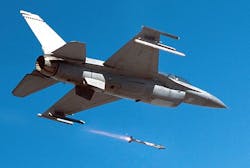Raytheon wins $434.4 million order to build 926 AIM-9X air-to-air missiles for combat aircraft
Officials of the Naval Air Systems Command at Patuxent River Naval Air Station, Md., are asking the Raytheon Missile Systems segment in Tucson, Ariz., to build lot-18 AIM-9X block II air-to-air missiles. The order consists of 766 AIM-9X Block II missiles and 160 AIM-9X Block II+ missiles.
These sophisticated short-range air-to-air weapons are for the U.S. Navy, Air Force, and military forces of Israel, Norway, Qatar, South Korea, the United Arab Emirates, Australia, and The Netherlands.
The contract also includes captive air training missiles; special air training missiles; missile containers; spare advanced optical target detectors; spare guidance units; spare captive air training missile guidance units; guidance unit containers; spare advanced optical target detector containers; and a spare block II propulsion steering section.
The AIM-9X is an infrared heat-seeking missile that equips most jet fighters, fighter-bombers, and other offensive combat aircraft in the U.S. arsenal, and is for shooting down enemy aircraft close-by. The AIM-9X works by homing in on an enemy aircraft's hot engine exhaust. Variants of the AIM-9 Sidewinder have been deployed since the 1950s.
The AIM-9X is among the latest versions of the AIM-9 missile family. It entered service in 2003 on the Navy F/A-18C Hornet fighter-bomber and on the U.S. Air Force F-15C jet fighter. It has an imaging infrared focal plane array seeker with 90-degree off-boresight capability for accuracy.
The missile is compatible with helmet-mounted displays such as the U.S. Joint Helmet Mounted Cueing System, and features 3-D thrust-vectoring control for increased turn capability. The AIM-9X also includes an internal cooling system.
This contract involves the latest version of the AIM-9X, called the AIM-9X Block II. This newest version has lock-on after launch capability for use with the F-35 Lightning II joint strike fighter and the F-22 Raptor advanced tactical fighter.
On this contract modification Raytheon will do the work in Tucson, Ariz.; Andover and Amesbury, Mass.; Santa Clarita, Valencia, Chatsworth, San Diego, San Jose, El Cajon, and Claremont, Calif.; Sumner, Wash.; Hillsboro, Ore.; Cincinnati; Cheshire and Simsbury, Conn.; Keyser; Ontario, Canada; Heilbronn, Germany; Anniston, Ala.; and in other locations in the U.S., and should be finished by March 2021.
For more information contact Raytheon Missile Systems online at www.raytheon.com, or Naval Air Systems Command at www.navair.navy.mil.
Ready to make a purchase? Search the Military & Aerospace Electronics Buyer's Guide for companies, new products, press releases, and videos
